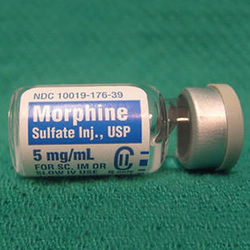DRUGS: WHAT YOU
NEED TO KNOW Booklet

Signs and Symptoms of Morphine Addiction

Courtesy of DEA.gov
Morphine is a derivative of opium that has been used for pain relief in medicine for more than two hundred years. In the Civil War years, it was used to relieve the agony of surgery and amputations. However, its liberal use during this war relieved excruciating pain but also resulted in widespread addiction.
Heroin was developed as a solution to morphine addiction, but, as everyone now knows, it became a problem in itself. While there have been many more efforts to create other opioids that work better or are less addictive, morphine is still a medical drug that’s widely used to relieve pain. It’s also an addictive substance abused by those who may get it from a doctor or from the illicit market.
Morphine and codeine are the only opioid painkillers directly derived from opium. All others are semi-synthetic as in the case of oxycodone or hydrocodone. Or they may be fully synthetic like fentanyl is.
Morphine Abuse in America
The Substance Abuse and Mental Health Services Administration (SAMHSA) monitor the abuse of both prescription drugs and street drugs and record how many people suffer from addiction to these drugs.1 SAMHSA provides statistics on the abuse of morphine and other opioids.
Once a person is addicted to an opioid, they are very likely to use many different opioids in the time that addiction lasts. They could use morphine, codeine, heroin, oxycontin, fentanyl—any of these drugs will maintain their addictions and keep them from going into withdrawal sickness.
This is the situation faced by 2.3 million Americans—they have a daily need for a prescription opioid to keep withdrawal sickness at bay. Another 900,000 are using heroin and of these, nearly 700,000 are addicted to this drug.
Of the 2.3 million people misusing a prescription opioid, about 700,000 are misusing or are primarily addicted to morphine.
In all, more than nine million people misuse prescription opioids every year. This could mean that they borrowed a pill from someone else’s prescription or that they were fully addicted—anywhere within that very wide range.
If you are being prescribed morphine, your medication could be called MSContin, Kadian, Oramorph SR, Roxanol, Morphgesic, Sevredol or Morphabond, among others.
Physical Signs of Morphine Addiction

Because morphine is a pain reliever, a person will feel less pain while affected by the drug. This effect can actually mask signs of illness or injury suffered during the addiction. For example, opioids slow down the function of the lungs, which is how they can cause a fatal overdose—the person stops breathing. This also means that these impaired lungs are more susceptible to infection, such as pneumonia or tuberculosis.
The pain-deadening effects of morphine may mean that the person is sick but doesn’t know it because they don’t feel the pain. Even if they need medical help, they may not seek it for this reason.
Other signs of morphine abuse and addiction include:
- Nausea and vomiting
- Constant scratching of the nose and face
- Confusion, sedation and lethargy
- Constipation
- Euphoria
- Cold sweats
- Small pupils
Sometimes, family members only realize that a person is using or addicted to drugs by adding up the signs. The addicted person may be afraid to admit their problem or may feel so ashamed they don’t feel they can ask for help. Knowing the signs of morphine abuse or addiction can help a family identify this problem when it occurs.
Behavioral and Emotional Signs of Morphine Use
Changes related to morphine use come from two sources: the effects of the drug itself as listed above and the changes a person goes through because they are addicted. When behavioral signs like the following are seen, there is a reason a person is struggling like this. Whether it is a drug-related cause or some other personal problem, these changes are a sign that someone needs help.

Here are some of the signs that may be seen as a result of being addicted to drugs of any type:
- Change of associates (to a group of drug-using friends, in most cases)
- Isolation from friends and family
- Loss of interest in goals and activities that interested them before
- Poor hygiene and grooming
- Changes in mood and irritability
- Change in sleeping habits
- Poor performance in school or at work
- Legal problems
- Financial problems
The Long-Term Damage of Morphine Addiction
As noted above, morphine is hard on a person’s lungs which can predispose them to respiratory problems. If a person is crushing morphine pills, dissolving them and injecting the drug, they are likely to suffer staph, strep or fungal infections, heart infections and abscesses.
Emotionally and behaviorally, they are likely to suffer these effects:
- Deteriorating lifestyle
- A sense of guilt or shame
- Depression
- Compulsively seeking drugs to the exclusion of other interests or responsibilities
There is also a risk that a person who is currently addicted to morphine could transition to heroin if they can’t get the morphine they want.2 This puts them at immediate risk of overdose because of the varying potency of heroin. They may also be exposed to HIV, Hepatitis C or other illnesses if they inject these drugs, from contaminants in the heroin itself.
Morphine Overdose
If a person consumes too much morphine, these signs could be present: 3
- Slowed breathing
- Dopiness or unconsciousness
- Inability to be roused
- Bluish skin, nails or lips
- Clammy skin
- Snoring, gasping, gurgling
- Slowed heartbeat
- Pinpoint pupils
- Vomiting
- Seizures
Death is a possible outcome of a morphine overdose. Medical help must be summoned immediately if these signs are observed. Naloxone can be given as an antidote to morphine which should bring a person back to consciousness. This antidotal drug is routinely stocked by emergency medical personnel and is often available to family members of a person susceptible to possible opioid overdose.
Withdrawal from Morphine

There’s a long list of symptoms associated with morphine withdrawal, the same as with any withdrawal from an opioid. The severity of these symptoms is a big part of why recovery from opioid addiction is so difficult. A person may get into the early part of this withdrawal sickness and abandon the effort to get sober because they get so sick. This is what they will suffer as their body begins to eliminate the morphine or other opioid they were using:
- Anxiety
- Agitation
- Muscle and bone pain
- Sleep problems
- Stomach cramps
- Diarrhea
- Nausea
- Vomiting
- Restless and jerking legs
- Chills
- Drug cravings
Some people coming off opioids describe the sickness as the “worst flu anyone could possibly have.”
Finding Help
A person who is addicted to morphine is at immediate risk of loss of life. Those addicted to morphine may reach out for any other opioid that is available, including heroin. The supplies of heroin in America are often contaminated with the powerful synthetic opioid fentanyl. A person may try to buy morphine pills on the illicit market and wind up with counterfeit pills that contain a lethal dose of fentanyl. Someone who is addicted to morphine is at risk until they can get the support they need to recover their sobriety.
The right time to get them help is now. A family may not be able to save a loved one if they wait until that person asks for help.
Sources:
-
SAMHSA. “Key Substance Use and Mental Health Indicators in the United States: Results from the 2020 National Survey on Drug Use and Health.” Substance Abuse and Mental Health, 2021. SAMHSA Article (PDF) ↩︎
-
National Institute on Drug Abuse. “Prescription opioid use is a risk factor for heroin use.” NIDA, 2018. NIDA Research Reports ↩︎
-
MedlinePlus. “Opioid Abuse and Addiction." MedlinePlus, 2021. MedlinePlus Article ↩︎


